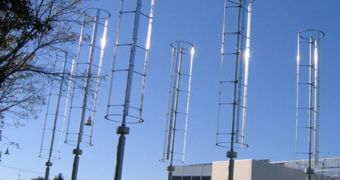According to a growing body of evidence, it may be that rearranging wind turbines in fish school-like patterns could contribute to reducing the land surface the large structures take up, while at the same time preserving, or even increasing the output. Estimates say that the surface such a setup would occupy would be 100 times smaller than the one current wind farms take up from other uses. Other scientists consider that this approach could also see a reduction in the number of birds that are being killed by wind turbines yearly, ScienceNow reports.
The basic principle that allows for such a way of structuring wind farms to be feasible is the basic concept of drafting, which is used in everything from races to fish swimming. In the case of two cars trying to beat each other, the one at the back benefits from a speed boost, if it trails the car in front of it bumper to bumper. This is owed to the fact that air flowing over the first car is redirected over the second one as well. The latter therefore experiences less drag and is able to move faster than the one in front of it. The same holds true for fish, where the ones in front lead the way for the others.
The issue with wind farms is that horizontal wind turbines do not benefit from the obvious advantages of drafting. The blades of the turbine in front create massive amounts of turbulences in the air flow, which means that the turbines in the back do not benefit from the same steady current that would drive their rotors efficiently. However, this issue disappears completely in the case of vertical wind turbine. Granted, they are less common than their cousins, but they do not require to be stretched over hundreds of hectares, so that turbulences from one do not affect the others. Additionally, some people in surrounding areas consider the giant turbine fields to be unsightly.
Just recently, two California Institute of Technology (Caltech) fluid dynamics experts, Robert Whittlesey and John Dabiri, have discovered that vertical-axis wind turbines (VAWT) were extremely efficient at handling air flows. After setting up an experiment, they turned to analyzing fish school moving patterns, to see how flow is increased and decreased based on this geometry. The research showed that the best course of action was to place several VAWT after a leader. This arrangement did not create turbulences in the air flow and therefore did not cause a drop in output.

 14 DAY TRIAL //
14 DAY TRIAL //